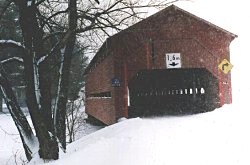 There are twenty-one authentic covered bridges remaining in the Eastern Townships. To that total may be added two semi-authentic recreations of recent vintage. A century ago, there were hundreds of covered bridges all across the region. Most villages had at least one; some had several. They dotted the back roads as well, crossing brooks and rivers of all sizes. Very few, however, have survived the ravages of time.
There are twenty-one authentic covered bridges remaining in the Eastern Townships. To that total may be added two semi-authentic recreations of recent vintage. A century ago, there were hundreds of covered bridges all across the region. Most villages had at least one; some had several. They dotted the back roads as well, crossing brooks and rivers of all sizes. Very few, however, have survived the ravages of time.
The harsh climate, arson, motor vehicle accidents, neglect, floods, casual vandalism, and replacement by modern structures, have all taken their toll. In the last few years alone, an alarming number of these bridges have disappeared. And some of the ones that do remain are in very poor repair. Whether or not they survive depends largely on our desire to preserve them.
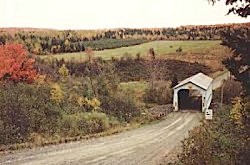 People have often speculated about why bridges were covered in the first place. Some believe that roofs were designed to provide travellers and their horses with shelter when it rained or snowed. Others think that the walls and a roof were there so that horses would not see the turbulent waters below. Folklore has it that sweethearts would rendezvous in covered bridges; hence the common nickname "kissing bridge." The real reason for covering a bridge with a roof and walls, however, was far less romantic. It was to protect the bridge's structure from the elements.
People have often speculated about why bridges were covered in the first place. Some believe that roofs were designed to provide travellers and their horses with shelter when it rained or snowed. Others think that the walls and a roof were there so that horses would not see the turbulent waters below. Folklore has it that sweethearts would rendezvous in covered bridges; hence the common nickname "kissing bridge." The real reason for covering a bridge with a roof and walls, however, was far less romantic. It was to protect the bridge's structure from the elements.
A simple open bridge composed of beams ("stringers") and decking had a very limited life expectancy - perhaps ten or twenty years. After that it would begin to rot and sag. A bridge with a "truss"(a superstructure of interlocking timbers designed to support whatever weight was put upon the deck) would not only be much more solid, but would last longer as well. Yet, although the sagging would be impeded, the elements would eventually still cause the bridge to rot. However, if the bridge were protected with a roof and walls, its life could be prolonged by as much as ten times that of an open span, whose timber beams, flooring, and trusses would be constantly exposed to the weather.
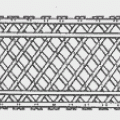 Covered bridges have existed for centuries. The oldest survivors are in Europe, and date to the Middle Ages. Colonists who came to the New World in the 17th and 18th centuries are thought to have brought the technology with them. As a result, covered bridges have been built in virtually every part of the United States, as well as in Quebec, Ontario, and the Maritimes.
Covered bridges have existed for centuries. The oldest survivors are in Europe, and date to the Middle Ages. Colonists who came to the New World in the 17th and 18th centuries are thought to have brought the technology with them. As a result, covered bridges have been built in virtually every part of the United States, as well as in Quebec, Ontario, and the Maritimes.
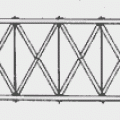 It was the Americans, in the 19th century, who truly perfected the science of the covered bridge. Throughout the 1800s, an array of inventors and engineers came up with an impressive repertoire of truss designs. They realized that the truss was the most important part of a bridge. The stronger the truss, the longer the covered bridge would last. Many of these men gave their names to their inventions: Moses Long, Herman Haupt, Theodore Burr, Peter Paddleford, William Howe, Willis Pratt, and Ithiel Town are some of the better known designers. Today in the Eastern Townships, there are three basic types of covered bridge that have survived (see diagram). The most common is the "Town Truss," patented by Ithiel Town in 1820.
It was the Americans, in the 19th century, who truly perfected the science of the covered bridge. Throughout the 1800s, an array of inventors and engineers came up with an impressive repertoire of truss designs. They realized that the truss was the most important part of a bridge. The stronger the truss, the longer the covered bridge would last. Many of these men gave their names to their inventions: Moses Long, Herman Haupt, Theodore Burr, Peter Paddleford, William Howe, Willis Pratt, and Ithiel Town are some of the better known designers. Today in the Eastern Townships, there are three basic types of covered bridge that have survived (see diagram). The most common is the "Town Truss," patented by Ithiel Town in 1820.
Two other types, extinct elsewhere in Quebec, are the unpatented "Multiple Kingpost" truss, and the "Howe" truss, also unpatented, but named after its inventor, William Howe.
The region numbers two Howe truss bridges and two Multiple Kingposts. All the others are variations of the Town truss.
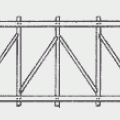 Quebec now numbers just over ninety covered bridges, some built as late as the 1950s.The Eastern Townships are home to some of the oldest and most picturesque in the Province.
Quebec now numbers just over ninety covered bridges, some built as late as the 1950s.The Eastern Townships are home to some of the oldest and most picturesque in the Province.
The following is a list of authentic covered bridges in the Eastern Townships:
1) Warwick. (Private bridge). Des Pins River. Town Truss. 1908.
2) Saint-Rémi-de-Tingwick. (Private bridge). Laflamme Brook. 1904.
3) Saint-Éphrem. (Private bridge; moved from its original location after a fire). Town Truss. 1933.
4) Sainte-Clothilde. Dupuis-Fortin River.Town Truss. 1937.
5) Adamsville. Yamaska River. Town Truss. 1932.
6) Adamsville. Yamaska River. Town Truss. 1938.
7) Mansonville (Potton). Mud Creek, Town Truss. 1896.
8) Compton. Massawippi River. Multiple Kingpost Truss.
9) Eustis (Compton Station). Massawippi River. Multiple Kingpost Truss. 1908.
10) Cookshire. Eaton River. Town Truss. 1868.
11) Eaton Township. North Eaton River. Multiple Kingpost. 1886.
12) Gould. Au Saumon River. Town Truss. 1893.
13) Drummondville. Village québécois d'antan. Howe Truss. 1878. (Moved from Stanbridge East in 1983 to its present location).
14) Sainte-Agathe-de-Lotbinière. Palmer River. Town Truss. 1928.
15) Sainte-Sophie. Bulstrode River. Town Truss. 1948.
16) Saint-Armand. Groat Creek. Town Truss. 1845.
17) Cowansville. Yamaska River. Town Truss. c.1870.
18) Notre-Dame-de-Stanbridge. Aux Brochets River. Howe Truss. 1884.
19) Valcourt. (Private bridge). Brady River. Town Truss. 1888.
20) Milby. Moe's River. Town Truss. 1873.
21) Fitch Bay. Narrows of Lake Memphremagog. Town Truss. 1881.
Recent semi-authentic covered bridges have been built at the following locations:
22) Ulverton. Adjacent to the Ulverton Woolen Mill. Ulverton River. Town Truss, with steel I-beams. 1994.
23) Coaticook. Located in the Gorge de Coaticook Park. Town Truss, with steel I-beams. Coaticook River. 1998.